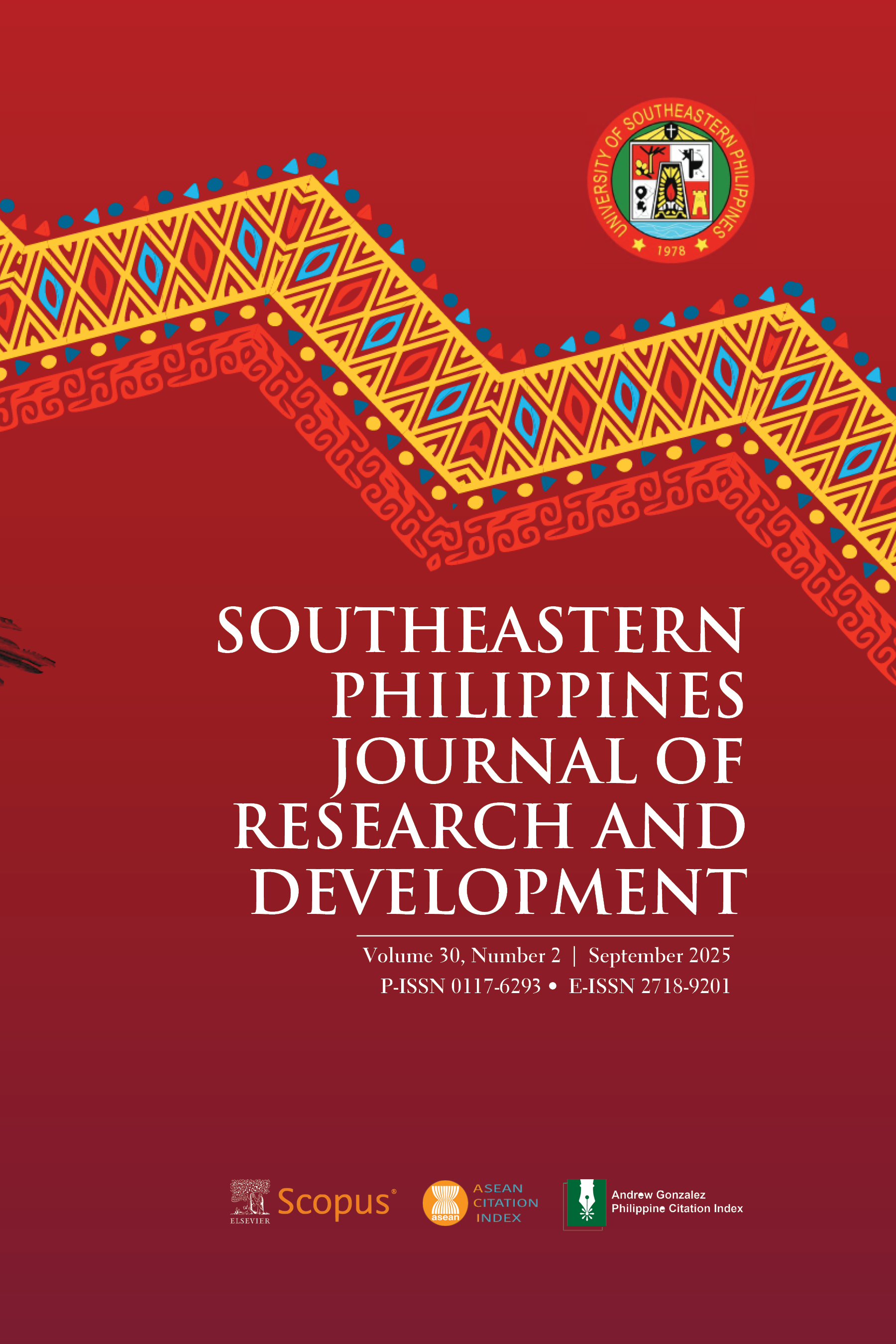Buried Memories, Imagined Wealth: Yamashita Treasure as Collective Memory in Everyday Life in Mindanao
DOI:
https://doi.org/10.53899/spjrd.v30i2.1112Keywords:
Yamashita Treasure, collective memory, ethnography, Philippines-Japan relationship, MindanaoAbstract
This paper examines how Yamashita Treasure—an allegedly buried wartime hoard left by the Japanese military in the Philippines—continues to be remembered, narrated, and imagined in the everyday lives of residents in Mindanao. Based on an ethnographic methodology involving long participant observation in four field sites between 2015 and 2024, and coding of the obtained data, the study explores how ordinary people encounter and interpret traces believed to indicate the presence of the treasure—such as fragments of pottery, symbolic carvings on rocks, or cryptic maps—as well as unexpected events like sudden economic success or the rare arrival of Japanese visitors. These materials and incidents are rarely verified through historical inquiry but are instead animated by collective imagination, subaltern knowledge production, and deeply embedded wartime memories. Engaging with postcolonial theory, the paper argues that narratives surrounding the treasure do not merely reflect rumor or folklore. Rather, they serve as a grassroots form of war memory, indirectly recalling Japan’s occupation of the Philippines. While the treasure’s existence remains uncertain, its imagined presence generates a sense of possibility—a hope for future prosperity grounded in a painful past. As such, the narration of the Yamashita Treasure becomes a means of simultaneously resisting historical forgetting and producing future-oriented imaginaries. By analyzing these everyday practices and representations, this study contributes to broader discussions on postcolonial memory, hope, and the lingering effects of war.
Downloads
References
Abu-Lughod, L. (2016). Veiled sentiments: Honor and poetry in a Bedouin society. University of California Press. https://doi.org/10.1525/9780520965980
Agar, M. (1980). The professional stranger: An informal introduction to ethnography. Academic Press.
Bernard, H. R. (2018). Research methods in anthropology: Qualitative and quantitative approaches. Rowman & Littlefield.
Bersales, J. E. R. (2016). Looking for Yamashita’s gold. Philippine Quarterly of Culture and Society, 44(3–4), 183–210. https://tinyurl.com/5tzz2ujy
Campoamor II, G. A. (2009). Phases and faces in the Filipino war film: Images of the Japanese invader and the Filipino in contemporary Philippine cinema. Philippine Studies, 57(1), 77–104.
Charmaz, K. (2014). Constructing grounded theory. Sage Publications.
Chrysaetos, A. (2013). General Yamashita’s dream book: How to successfully find hidden treasure in the Philippines. New Generation Publishing.
Connerton, P. (2008). Seven types of forgetting. Memory Studies, 1(1), 59-71. https://doi.org/10.1177/1750698007083889
Foster, G. M. (1964). Treasure tales and the image of the static economy in a Mexican peasant community. The Journal of American Folklore, 77(303), 39–44.
Freud, S. (1957). Mourning and melancholia. In J. Strachey (Ed. & Trans.), The standard edition of the complete psychological works of Sigmund Freud (Vol. 14, pp. 243–258). Hogarth Press. (Original work published 1917).
フクミツ, ミノル. (Fukumitsu, M.). (1972). 将軍山下奉文:モンテンルパの戦犯釈放と幻の財宝 [General Tomoyuki Yamashita: Release of war criminals in Montelompa and phantom treasure]. 朝雲新聞社.
Gibbs, R. G. (2018). Analyzing qualitative data (2nd ed.). Sage Publications. https://doi.org/10.4135/9781526441867
Halbwachs, M. (1980). The collective memory (F. J. Ditter Jr. & V. Y. Ditter, Trans.). Harper & Row. (Original work published 1950).
早瀬, 晋三 (Hayase, S). (2004). 地域研究と歴史研究のはざまで:フィリピン史で論文を書くとき [Between historical and area studies: Writing academic papers on Philippine history]. 法政大学出版局.
Hayase, S. (2014). Japanese in modern Philippine history. Waseda University, Institute of Asia-Pacific Studies.
Inquirer.net. (2017, March 16). Hunt for Yamashita treasure in Baguio on. Inquirer.net. https://tinyurl.com/2mpdjy7s
Inquirer.net. (2022, January 26). Marcos: If they know something… I need that gold. Inquirer.net. https://tinyurl.com/2stx4th4
José, R. T. (2011). War and violence, history and memory: The Philippine experience of the second world war. In R. Waterson & K. Kian-Woon (Eds.), Contestations of memory in Southeast Asia (pp. 185–199). NUS Press.
梶原, 景昭. (Kajiwara, K.). (1995). 「山下財宝」 の行方 [The whereabouts of “Yamashita’s Treasure”]. 年報人間科学 [Annals of Human Sciences], 16, 21-37.
Linantud, J. L. (2008). War memorials and memories: Comparing the Philippines and South Korea. International Journal of Heritage Studies, 14(4), 347-361. https://tinyurl.com/ynvt3uen
Malinowski, B. (1922). Argonauts of the Western Pacific. Routledge.
McDougald, C. C. (1993). Asian loots: Unearthing the secrets of Marcos, Yamashita and the gold. San Francisco Publishers.
Miyazaki, H. (2004). The method of hope: Anthropology, philosophy, and Fijian knowledge. Stanford University Press.
Nakano, S. (2011). Memory and mourning: Six decades after the two wars. In K. Fujiwara & Y. Nagano (Eds.), The Philippines Japan and in America’s shadow. NUS Press.
生江, 有二 (Namae, Y.). (1995). 山下財宝:フィリピン黄金伝説を行く [Yamashita’s treasure: Following the Philippine gold legend]. 文藝春秋.
Olick, J. K., & Robbins, J. (1998). Social memory studies: From “collective memory” to the historical sociology of mnemonic practices. Annual Review of Sociology, 24(1), 105–140. https://doi.org/10.1146/annurev.soc.24.1.105
Roxas v. Marcos, 89 Haw. 91, 969 P.2d 1209 (Haw. 1998). https://tinyurl.com/5n8chrf4
笹倉, 明 (Sasakura, A.). (1998). 最後の真実:山下財宝その闇の奥へ [The last truth: Into the depths of the Yamashita treasure]. KSS出版.
Seagrave, S., & Seagrave, P. (2005). Gold warriors: America’s secret recovery of Yamashita’s gold. Verso.
Spivak, G. C. (1988). Can the Subaltern speak? In C. Nelson & L. Grossberg (Eds.), Marxism and the interpretation of culture (Macmillan Education, pp. 271–313). Basingstoke.
Stoler, A. L. (Ed.). (2013). Imperial debris: On ruins and ruination. Duke University Press.
Strauss, A., & Corbin, J. (2015). Basics of qualitative research: Techniques and procedures for developing grounded theory. Sage Publications.
Umari, D. A. (1993). Tracing Marcos’ gold. Treasure Hunters’ Association of the Philippines.
Washbourne, J., Rector, J., & Alonso, A. (1998). Treasure hunting with direct-arrival transmission imaging. The Leading Edge, 17(7), 927–933. https://tinyurl.com/mruuzzs6
Wertsch, J. V. (1998). Mind as action. Oxford University Press.
Downloads
Published
How to Cite
Issue
Section
License
Copyright (c) 2025 Southeastern Philippines Journal of Research and Development

This work is licensed under a Creative Commons Attribution-NonCommercial-NoDerivatives 4.0 International License.





